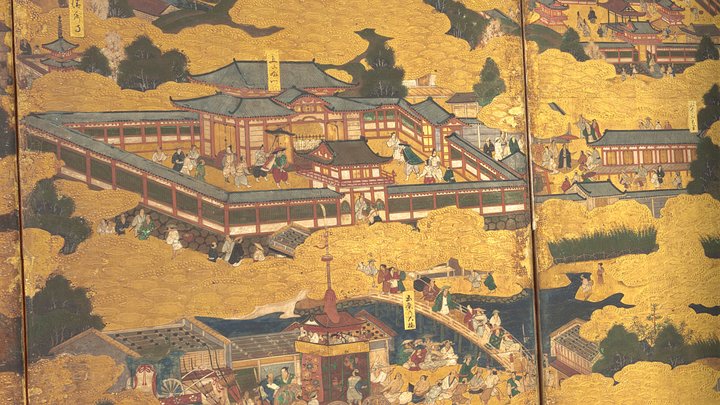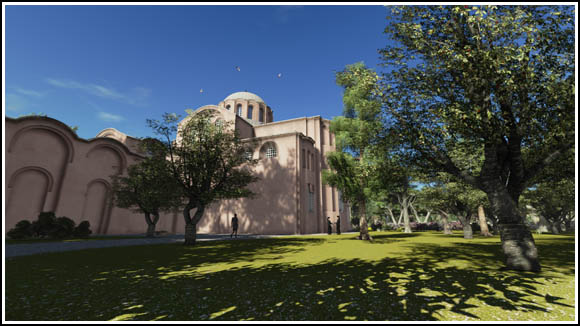Monks and nuns are a vital part and a common sight in the regions that follow Yeia's two most extented religions,
Yemuism and the
Ikarian Reformed Church. Their role is to pray to the gods to obtain their favour for the whole community as well as caring for the sick and the poor and those in need in general. Many of these monks have also turned to be great philosophers, trying to give some sort of explanation to the world we live in as well as the nature of human society.
Yemmuist monks
Monasticism as we understand it was founded in the
Seris Empire in 155 AP with the foundation of the School of Magic by Yemu in mount Nara and the subsequent network of monasteries that began to be built around
Sakouramish and later across the whole Seris Empire that followed the same rules and principles of the school founded by the great sage.

by Minneapolis Institute of Art.
This model was later exported, as the influence of Yumuism grew outside its native land, to the eastern regions of Karia (the Nari lands) and to the South-Western regions of Teria (the
Elvish-Oronai Kingdoms and
Wesdaland) where was also influenced by the native traditions of priesthood.
Requirements
Any man or woman can freely join a monastery to pursue a religious life and a life of learning to unlock the magical powers within one self and to use this adcquired magic to help others, everybody can join the monastery regarding of age as well, though it is preferable that the new monks be mostly young in order to reach their full potential.
After they're accepted into the monastery they undergo a three-month trial period where the other monks study their abilities and potential, as well as their decision to join the community. Afterward, they are allowed to take the vows and become full monks. Yemuist monks are given a magic staff, a symbol of their status and magical power.
Organization
The Yemuist faith has no central authority, though the abbot of the Magic School at Mount Nara has a position of preeminence in terms of doctrine. Each monastery is ruled by an abbot or abbess, elected by the monks themselves in an assembly. It's main duty is to make sure the monastic rules are followed and overseeing the day-to-day running of the monastery (asigning tasks to the other monks, and keeping the accounts of the monastery's economy).
When there is a dispute regarding doctrine or monastic rules, an assembly of abbots is summoned to discuss the problem and to solve it.
Life and role in society
Through their deeds, life style and piety, yemuist monks are expected to provide a living example to the community. They spend most of their time studying holy and magical texts, copying them, meditation and training their magical skills as well as helping the common folk through magic (curing illnesses, casting protective spells, multiplying food...).
The monks often rotate tasks each week, so one week you're in charge of the library and the next day you have to cook the meal for your brothers and sisters. Yemuist monks don't cultivate the land, so the food they eat is a result of donations from noble families or the faithful.
Clothing
The most characteristic feature of a Yemmuist monk are their orange or yellow robes. With some variations of desings depending on the different yemuist schools and the native influences of fashion.
Reformed Faith monks
Reformed faith monks share some similitudes with the Yemmuist monks because Yemmuist monasticism is the basis of monasticism in the Ikarian reformed faith thanks to the job of the founder of this monasticism, St. Baltazar , a former Yemuist monk, who adopted many elements of his previous faith and combined them with propper Ikarian practices such as the Houses of Prayer (the precursor of Reformed church monasticism) that existed in Ikaria since the first centuries after the preaching of the Prophet. In these places people gathered to live together studying the sayings of the
Prophet and putting in practice his teachings. It was also in these places where the teachings of the Prophet were written down for the first time and where new missionaries were educated so their value to the Reformed Church was inmense and it was from these places from where food and care was given to the poor and the needed.
St. Baltazar took these communal style of living and studying and added some Yumuist practices, like monastic rules, a focus not so much on studying the sacred scriptures to the letter but to help the poor and live according to the teachings of the prophet preventing the triumph of darkness over light. Over time his idea of monasticism spread across the Empire and beyond as new regions and countries converting to the faith. By the late Ikarian Empire and in the centuries inmediately after its collapse and the rise of its successor states rivalling to restore it, monasteries provide security, education, food and hope for a better future in those dark times.
Requirements
As with the Yemuist monks everyone can join the monastery and become a monk regardless of sex or age. The only requirements are their commitment to follow the teachings of the prophet, live in community and help the poor. Monks of the Reformed Church also have to undergo a three-month trial period to see if they can endure the monastic lifestyle. Once they pass this sort of test, they are fully ordained as monks.
Organization
Reformed church monasteries are ruled by an abbot or abbess, who is elected by the monks and whose main duty is to make sure the monastic rules are followed and overseeing the day-to-day running of the monastery. like Yemuist monasteries, but this is where similarities end. The hierarchy of Reformed Church monasteries is more complex , and it's partially inspired by the structure of the Imperial Blatian Bureaucracy. For example, there is an assembly of monks in each monastery in the image of the
Blatian Senate formed by the most senior monks and the abbot, which is called , for example, for solving theological doctrines, establishing the liturgies and religious ceremonies for the week, punishing disobedient monks, or assigning the tasks of the day or the week to each monk.
Life and role in society
Reformed Church Monks are believed to be the embodiment of the teachings of the Prophet, an example of faith , humility and dedication to one's neighbor. Though not as focused on magic as their Yemuist counterparts, some of the monks (like many priests) are expected to have some knowledge of magic. Instead, reformed church monks focus more on wisdom, many monasteries have big and extensive libraries with books of a wide variety of topics from magic to theology, history, philosophy, mathematics, geography..., and some very talented monks have become renown writers and thinkers across the Blatian world and even tutors of princes and emperors!.

by Byzantium1200
Another key difference between Yemuist and Reformed Church monks is that the latter cultivate their own food (aside of donations from patrons or common people) because, as St. Baltazar points out in one of his writings:
A monk must be pious towards the gods and an example of humility and hard work, and what better way of showing that and also pay hommage to the holy mother Tyr than growing our own food from her womb like farmers do?. And once you've achieve a suplus to survive the year, give the rest to the needed, feed not only their souls but also their stomachs!
Clothing
Reformed Church monks' clothing is very varied in terms of color. Many groups of reformed monks wear blue robes and tall cylindrical, usually decorated with religious motifs such as the eight-pointed star, the symbol of
Abbon Shabai, the god of wisdom. Some sects like the
Marylians wear grey robes while the
Constantinians, the descendants of the old
Petrines wear brown robes and not hats at all.








This is great! I'm curious, considering their access to knowledge and the nature of the order and their vows, how do they participate, if at all, in the general education of the lay community? For instance, do they send a monk to rural communities or lecture at the variour educational levels? It would be an interesting aspect of their devotion to explore.